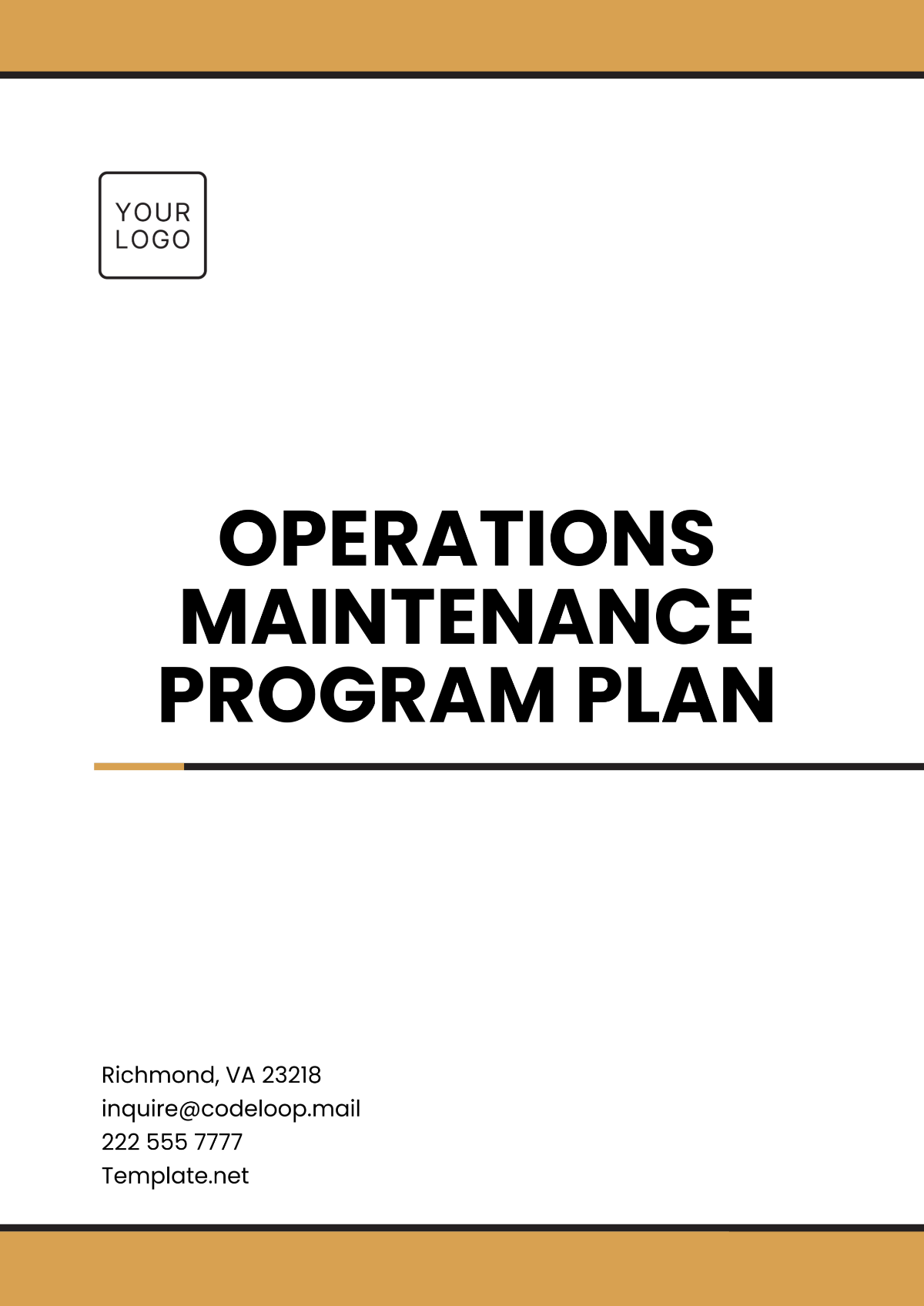Operations Maintenance Program Plan
Prepared By: | [Your Name] |
Company: | [Your Company Name] |
Date: | [Date] |
Introduction
An effective Operations Maintenance Program is critical to ensuring the optimal performance, longevity, and reliability of equipment and systems within an organization. This program is designed to prevent downtime, extend the life cycle of assets, and ensure the smooth functioning of day-to-day operations. The following plan outlines the key components, processes, and strategies for maintaining equipment, machinery, and operational systems.
Objectives
The primary objectives of the Operations Maintenance Program are to:
Maximize the reliability and efficiency of equipment.
Reduce the frequency and impact of equipment failures.
Optimize resource usage, including labor and materials.
Maintain regulatory compliance and safety standards.
Minimize operational disruptions by ensuring proactive maintenance.
Key Components of the Plan
1. Preventive Maintenance (PM)
Preventive maintenance involves scheduled inspections, cleaning, and servicing of equipment to prevent failures before they occur. Key activities under PM include:
Inspection Schedules: Regular checks of critical equipment, systems, and components.
Lubrication and Cleaning: Ensuring equipment is well-lubricated and free of debris that could cause wear.
Component Replacement: Replacing parts that are prone to wear, such as filters, belts, and seals, based on manufacturer guidelines.
Performance Monitoring: Using tools to measure performance and identify early signs of wear or inefficiency.
2. Corrective Maintenance (CM)
Corrective maintenance refers to repairing equipment that has already broken down or is malfunctioning. This can be classified into two types:
Reactive Maintenance: Addressing unplanned equipment breakdowns that occur during operations.
Predictive Maintenance: Utilizing data and monitoring systems to predict potential failures, allowing for repairs before the equipment fails.
3. Scheduled Downtime
Scheduled downtime is a necessary part of the maintenance plan to facilitate the execution of preventive and corrective maintenance activities. This includes:
Shut-Down Planning: Coordinating with operational departments to ensure minimal disruption during maintenance.
Resource Allocation: Ensuring that appropriate staff, tools, and parts are available for scheduled maintenance.
4. Spare Parts Management
Maintaining an adequate inventory of spare parts is essential for both preventive and corrective maintenance. This includes:
Inventory Tracking: Implementing an inventory management system to keep track of critical parts.
Supplier Relationships: Establishing relationships with key suppliers to ensure the availability of parts when needed.
Parts Forecasting: Analyzing historical data to predict future spare parts requirements.
5. Training and Development
Regular training ensures that maintenance personnel are equipped with the necessary skills and knowledge to perform their tasks efficiently. This includes:
Technical Skills: Training on new equipment, tools, and technologies.
Safety Procedures: Continuous education on safety protocols and regulatory compliance.
Troubleshooting: Equipping staff with the ability to quickly identify and solve operational issues.
6. Documentation and Reporting
Documenting all maintenance activities is crucial for tracking progress, ensuring accountability, and maintaining compliance. Key documentation includes:
Maintenance Logs: Recording all maintenance actions, including preventive checks and repairs.
Performance Reports: Tracking the performance of assets and identifying areas for improvement.
Compliance Records: Ensuring that maintenance activities meet regulatory requirements and industry standards.
7. Performance Metrics and KPIs
To evaluate the effectiveness of the Operations Maintenance Program, specific performance metrics and Key Performance Indicators (KPIs) should be established. These include:
Mean Time Between Failures (MTBF): The average time between equipment breakdowns.
Mean Time to Repair (MTTR): The average time taken to repair equipment after a failure.
Equipment Availability: The percentage of time that equipment is available for operation.
Maintenance Cost per Unit of Production: The cost of maintenance relative to the production output.
Implementation Timeline
The implementation of the Operations Maintenance Program will be phased over several stages to ensure smooth integration into daily operations.
Phase 1: Planning and Preparation (Months 1-2)
Develop and Approve Program Framework
Identify Critical Assets and Equipment
Set Up Maintenance Schedules
Establish Spare Parts Inventory System
Phase 2: Implementation (Months 3-6)
Execute Preventive Maintenance
Start Corrective Maintenance Procedures
Train Maintenance Personnel
Begin Performance Tracking and Reporting
Phase 3: Optimization (Months 7-12)
Review Maintenance Metrics and KPIs
Conduct Root Cause Analysis for Frequent Failures
Optimize Spare Parts Inventory
Implement Process Improvements Based on Data Analysis
Conclusion
An Operations Maintenance Program is essential for maintaining the efficiency, reliability, and safety of equipment within any organization. By focusing on preventive and corrective maintenance, regular training, and performance tracking, organizations can extend the lifespan of their assets and minimize costly downtime. With careful planning, execution, and continuous improvement, this program will provide significant value in ensuring smooth operations and long-term success.
Plan Templates @ Template.net






























